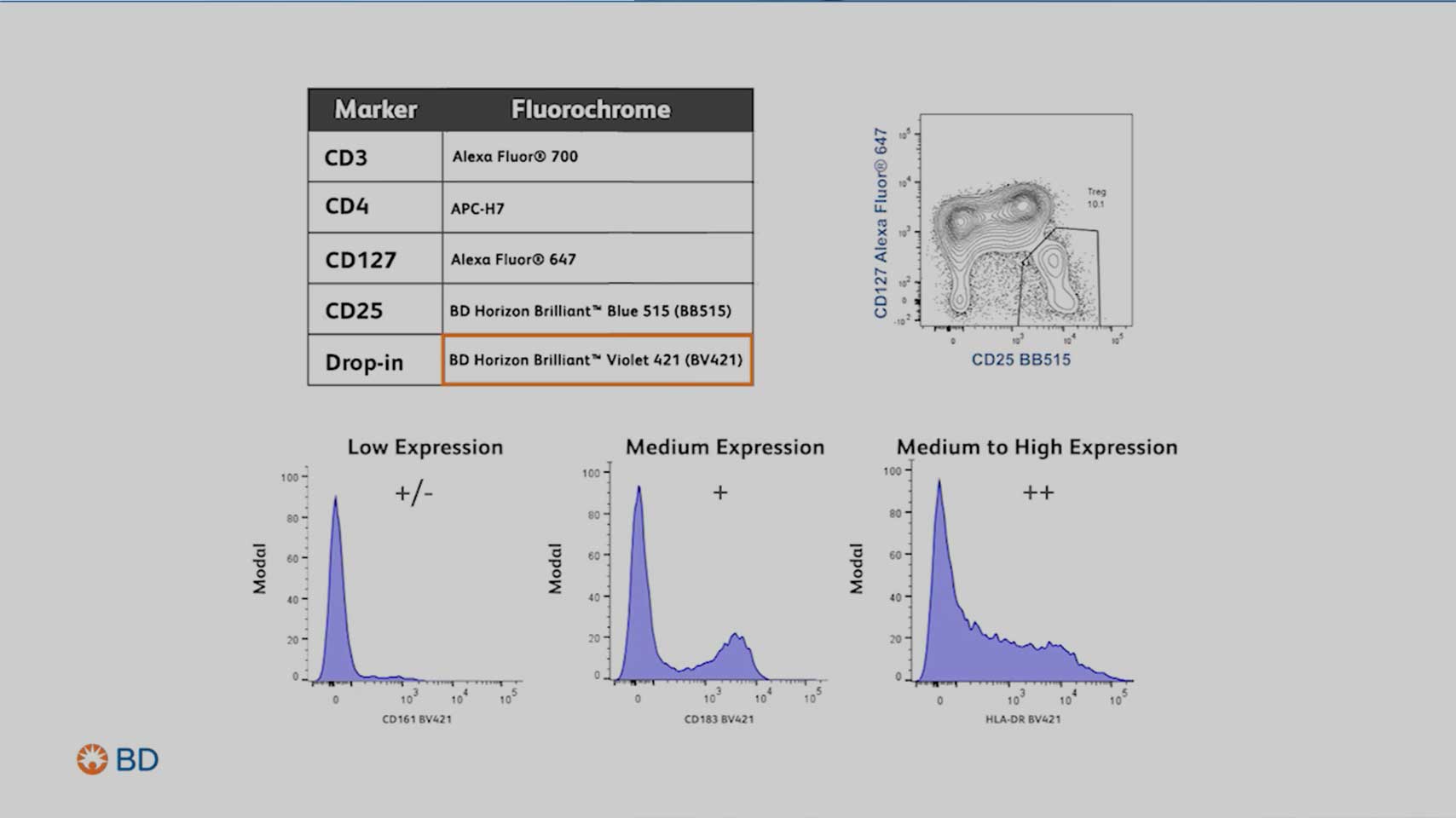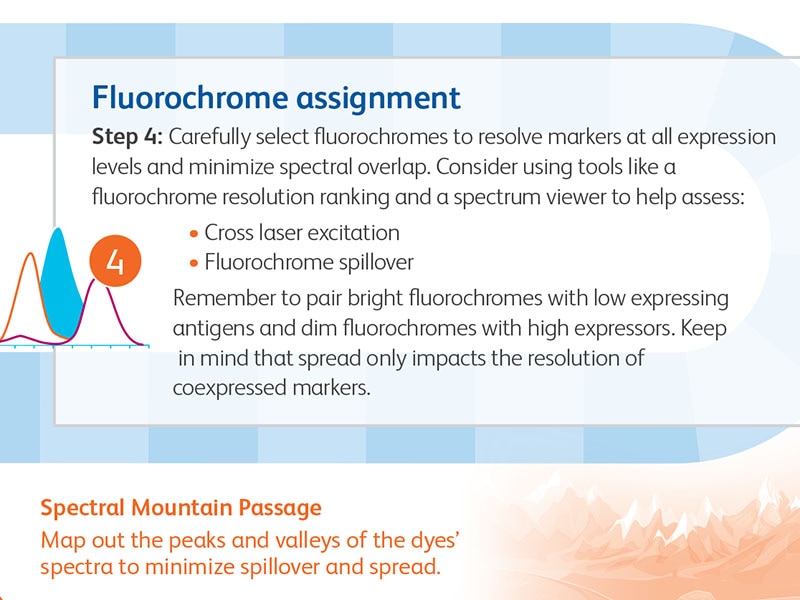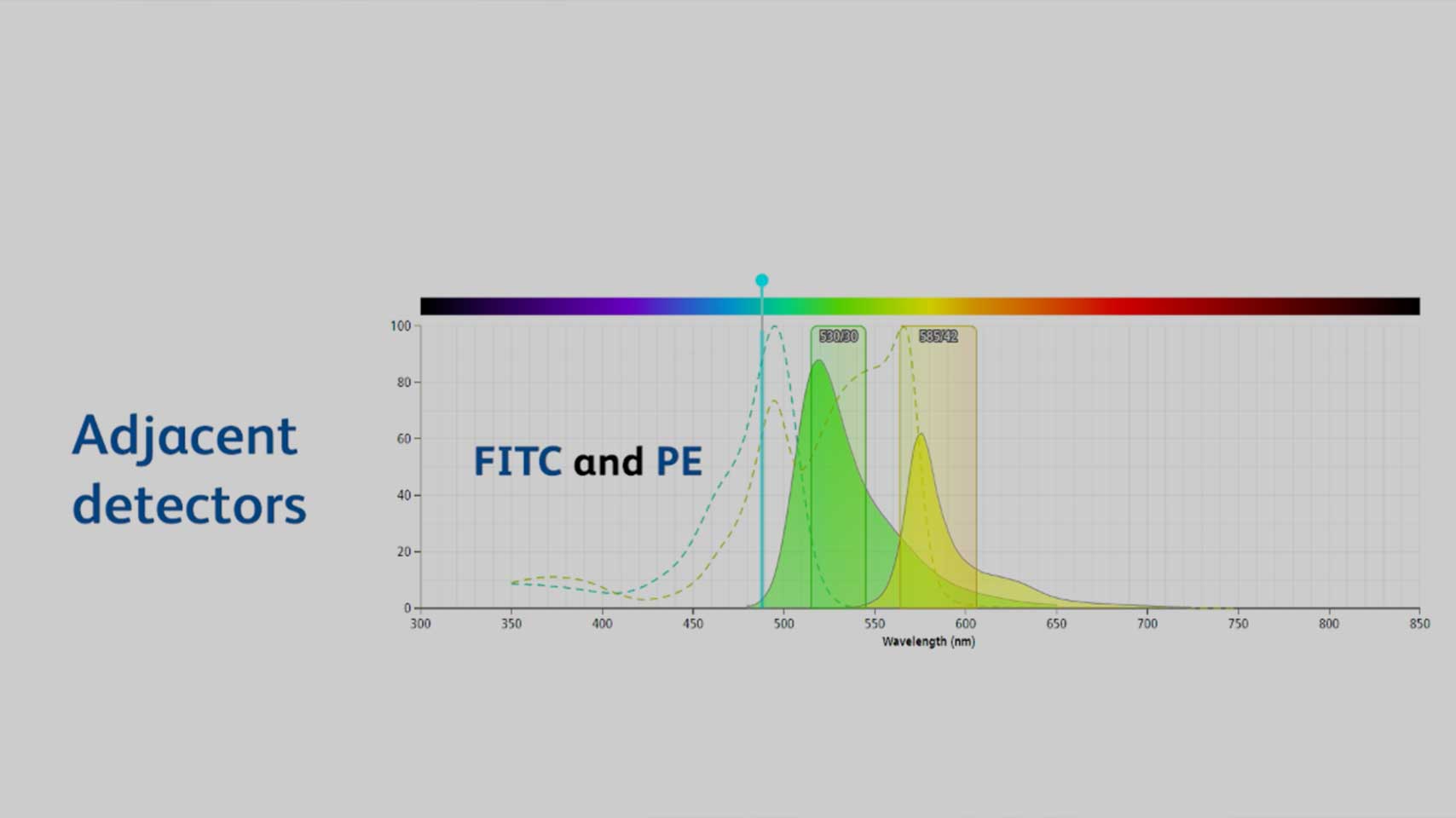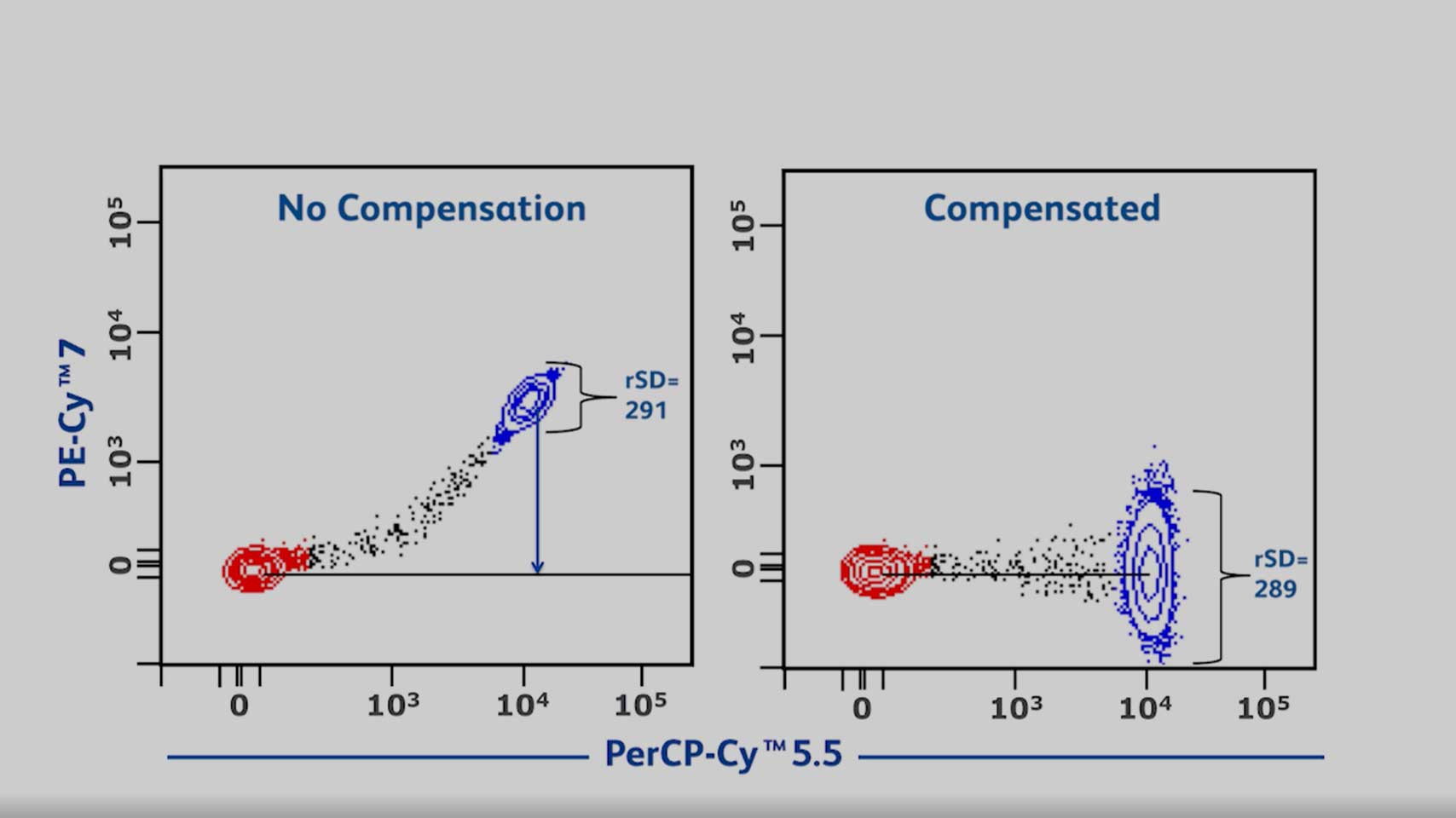Old Browser
This page has been recently translated and is available in French now.
Looks like you're visiting us from {{countryName}}.
Would you like to stay on the current country site or be switched to your country?
Panel Design
Multicolor flow cytometry is a powerful technology that enables the simultaneous analysis of multiple markers at the single-cell level. With the increase in the number of detectable parameters, the design of a multicolor flow cytometry panel can be challenging and requires an understanding of several factors that can influence panel performance:
- Biology—Antigen density and co-expression
- Fluorochrome—Brightness and spillover
- Instrument—Configuration and set-up
In the following series of videos, you can learn the essential principles of flow cytometry panel design from BD Biosciences experts. The antibody panel design process begins with the identification of a biological hypothesis and is followed (in order) by the selection of the markers to be detected, understanding the settings on your flow cytometer, assigning the right fluorochromes to the identified markers, and then reviewing your panel.
You can also use tools like OMIP or Optimised Multicolour Immunophenotyping Panels, to check whether a flow panel that may meet your requirements already exists.
Step 1
Define your experimental hypothesis
Defining your experimental hypothesis is the first step in flow cytometry panel design. Start with identifying:
- The biological information you are trying to obtain
- The population(s) of cells you wish to interrogate
- Which and how many markers you need
- Whether targets are found on the cell surface or intracellularly
The biological information that is desired is crucial as it dictates every other aspect of the flow cytometry experiment detailed in the coming steps.
It is always useful to learn all about the biology of your target cell populations and their markers from other sources, before embarking on an attempt to design your flow cytometry panel.
Watch the flow cytometry panel design step 1 video to begin your panel design journey.

Step 2
Select the right marker
During the second step of the panel design process, you will need to identify which and how many markers you need to identify in the cell population of interest.
Pay attention to:
- Marker expression levels
- Primary antigen: Expressed at high density, often defining lineages
- Secondary antigen: Often expressed over a continuum
- Tertiary antigen: Critical markers expressed at low density
- Marker co-expression, especially of dim markers
- The gating strategy needed to identify the population(s) of cells you wish to interrogate
Identifying the critical population will allow you to assign the fluorochromes with exceptional resolution to high-value markers that are instrumental in defining these critical populations. This will also enable you to map out the path towards detecting and analysing the critical populations using all the markers you have in your flow cytometry panel.
Watch the flow cytometry panel design step 2 video to understand the intricacies in identifying critical populations and selecting the markers for analysis.

Step 3
Know your flow cytometer
Knowing your instrument is essential. Understanding your instrument configuration will let you know how many markers and which fluorochromes your instrument can detect.
Elements to consider include:
- Laser wavelength for excitation
- Number of detectors for each laser
- Filters available to detect the fluorochromes
It is often said that the first step in learning to love others is to understand them. If you love flow cytometry, you must first understand your flow cytometer and its capabilities.
You need to know which flow cytometer to use, which has the right lasers and can detect all the parameters you need for the markers you wish to study. The fluorochromes you can use in your panel depend on the lasers and filters that are available on your flow cytometer, making this understanding vital for panel design.
Watch the flow cytometry panel design step 3 video to understand and maximize the capabilities of your flow cytometer.

Step 4
Assign the right fluorochromes to the markers
Carefully select fluorochromes to resolve markers at all expression levels and minimize spectral overlap. Consider using tools like a fluorochrome resolution ranking and a spectrum viewer to help assess:
- Cross laser excitation
- Fluorochrome spillover

Step 5
Review your panel
Review your panel design and begin ordering your reagents. Remember to titrate your mass size reagents and optimize your staining protocol. Include proper controls for compensation, FMO and biological controls to help ensure optimal panel performance.
To find more panel design tips and some fun facts, download the flow cytometry panel design journey infographic.

Avoiding Resolution Loss When Using Fix and Permeabilization Buffers for Intracellular Staining
In this video you will learn helpful strategies to help prevent loss of resolution due to intracellular fixation and permeabilization buffers.

Understanding and Managing Fluorescence Spillover
In this video you will learn how to manage fluorescence spillover to get the most out of your flow cytometry experiments.

Relationship Between Fluorescence Spillover and Spread
This video will help you understand the relationship between florescence spillover and spread to help you implement the right strategies to resolve your populations of interest.

Minimizing the Impact of Spread in Flow Cytometry Experiments
This video provides strategies to help minimize the impact of spread in flow cytometry experiments to help improve resolution.

Panel Design Workflow for Optimal Fluorochrome-Antigen Matching
This video provides simple strategies for fluorochrome-antigen matching to help prevent the introduction of spread and subsequent resolution loss.

BD Horizon™ Tour Series
This webinar explores concepts, best practices and available tools to help you efficiently navigate multicolor flow cytometry.
Speaker
Andrew D. Bantly
Technical Applications Specialist
Discover a new way of looking at fluorochromes and markers that can maximize the number of parameters achievable on any instrument.
Speaker
Bob Balderas, MBA
VP Biological Sciences & VP Market Development
BD Life Sciences–Biosciences
This webinar offers a comprehensive look at best practices for managing instrument set up to help you maximize your instrument’s parameters while minimizing spillover and resolution loss.
Speaker
Alan Stall
Principle Scientist
BD Life Sciences–Biosciences
This webinar explores the importance of understanding antigen density (the number of cell surface receptors on a cell) in relation to antibody/fluorochrome combinations for optimal panel design.
Speaker
Bob Balderas, MBA
VP Biological Sciences & VP Market Development
BD Life Sciences–Biosciences
This webinar explores the journey to finding what nature is hiding using flow cytometry by understanding the biology of your cells and the relative brightness of fluorochromes.
Speaker
Bob Balderas, MBA
VP Biological Sciences & VP Market Development
BD Life Sciences–Biosciences
BD Harmony Series
This webinar offers viewers practical strategies for designing optimized multicolor flow cytometry panels by addressing frequently asked questions.
Speakers
Bob Balderas, MBA
VP Biological Sciences & VP Market Development
BD Life Sciences–Biosciences
Mirko Corselli, PhD
Global Scientific Content Manager
BD Life Sciences–Biosciences
Rui Gardner, PhD
Head of Flow Cytometry Core Facility
Memorial Sloan Kettering Cancer Center
Yolanda Mahnke, PhD
Founder
FlowKnowHow LLC
This webinar is part of the Harmony Series and offers viewers panel design best practices, with emphasis on spillover and identification of optimal fluorochrome combinations to simplify panel design.
Speaker
Mirko Corselli, PhD
Global Scientific Content Manager
Research Solutions, BD Life Sciences–Biosciences
This webinar explores strategies to help customers create a solid chromatic foundation for multicolor panel design
Speakers
Bob Balderas, MBA
VP Biological Sciences & VP Market Development
BD Life Sciences–Biosciences
Other
This webinar explores strategies for minimizing flow cytometry panel design pain points as well as panel optimization
Speaker
Alan Stall
BD Fellow, Principal Scientist, BD Life Sciences–Biosciences
This webinar offers comprehensive strategies for adding efficiency to the flow cytometry panel design process
Speaker
Anis Larbi, PhD
Head of A*STAR Flow Cytometry Facility, Immuno-monitoring Platform and Principal Investigator, Biology of Aging Program
Singapore Immunology Network (SIgN)
This webinar provides a robust overview on compensation best practices to help achieve your resolution goals.
Speaker
Alan Stall
BD Fellow, Principal Scientist, BD Life Sciences–Biosciences
-
Posters
-
Tools
-
An Introduction to Compensation for Multicolor Assays on Digital Flow Cytometers
-
BD Biosciences Fluorochrome/Laser Reference Chart
-
BD Biosciences Fluorochrome Specifications Chart
-
BD Biosciences Relative Fluorochrome Brightness Chart
-
Human and Mouse CD Marker Handbook
-
Mouse Leukocyte Alloantigens Chart
-
Flow Cytometry Workflow Journey
Mahnke YD, Roederer M. Optimizing a multicolor immunophenotyping assay. Clin Lab Med. 2007;27(3): 469–485, v. doi: 10.1016/j.cll.2007.05.002
Mair F, Tyznik A. High-dimensional immunophenotyping with fluorescence-based cytometry: a practical guidebook. Methods Mol Biol. 2019;2032:1-29. doi: 10.1007/978-1-4939-9650-6_1
Nguyen R, Perfetto S, Mahnke YD, Chattopadhyay P, Roederer M. Quantifying spillover spreading for comparing instrument performance and aiding in multicolor panel design. Cytometry A. 2013;83(3):306-315. doi: 10.1002/cyto.a.22251
Roederer M. Spectral compensation for flow cytometry: visualization artifacts, limitations, and caveats. Cytometry. 2001;45(3):194-205. doi: 10.1002/1097-0320(20011101)45:3<194::aid-cyto1163>3.0.co;2-c
For Research Use Only. Not for use in diagnostic or therapeutic procedures.
BD Flow Cytometers are Class 1 Laser Products
Report a Site Issue
This form is intended to help us improve our website experience. For other support, please visit our Contact Us page.